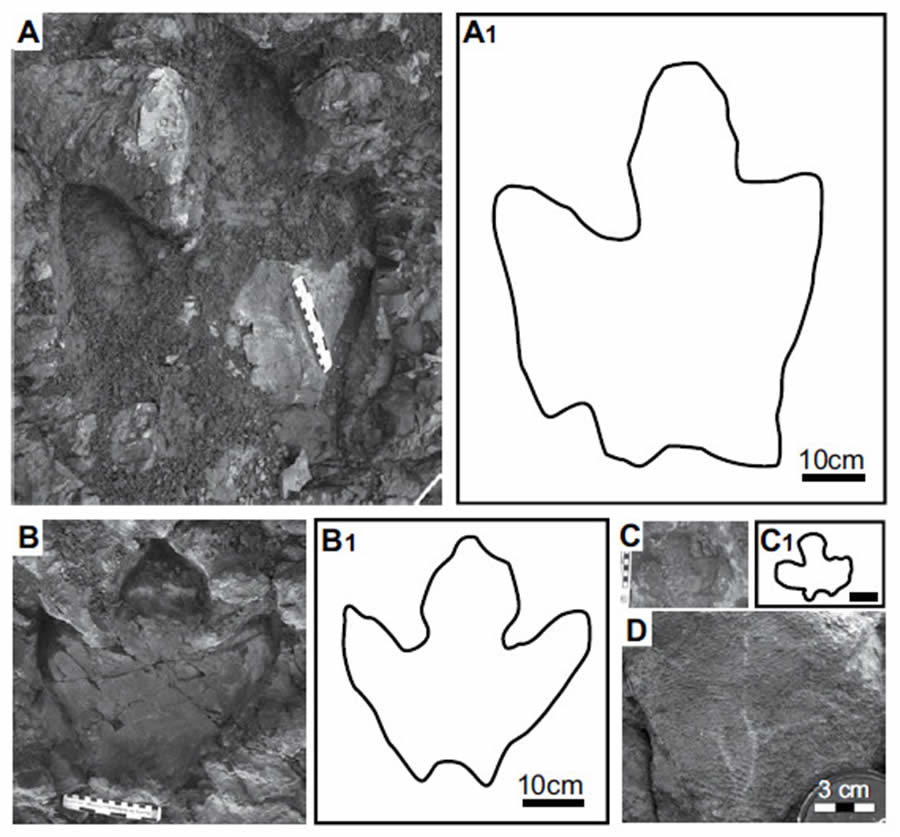
Do Duck-Billed Dinosaur Tracks Trace Hadrosaur Habits?
News to Know
Abstract
Duck-billed dinosaur families frolicked in Alaska’s Denali destination for millions of years, evolutionists say.
News Source
How much do we know about the lifestyles of dinosaurs? According to paleontologists investigating the latest trove of tracks in Alaska’s Denali National Park, quite a bit! Thanks to a jumble of tracks uncovered by a rockslide, paleontologist Anthony Fiorillo believes he can not only describe the flora and fauna amongst which duck-billed dinosaurs lived but even the social structure and seasonal habits of hadrosaur herds and family groups. (As we’ll see below, these tracks do tell a story, but not the one you may have seen in the news!)
Tracks Galore
Alaska’s many fossilized dinosaur tracks and bird tracks preserved in Cretaceous rock were first discovered in Denali National Park in 2005, and discoveries have continued in other places too, with a particularly rich find along the Yukon River. (Learn about that paleontological gold mine in “Alaskan Dinosaur Tracks Buried in the Global Flood.”) Fiorillo’s tracks take us back to Denali National Park. The tracks are in an Upper Cretaceous outcrop uncovered by erosion of a 590-foot-long cliff face. Fiorillo believes the tracks were left when a hadrosaur herd trampled a muddy riverbank 69 to 72 million years ago.
“Denali is one of the best dinosaur footprint localities in the world,” explains Fiorillo, curator of earth sciences at the Perot Museum of Nature and Science in Dallas. “What we found that last day [of the expedition] was incredible—so many tracks, so big and well preserved. Many had skin impressions, so we could see what the bottom of their feet looked like. There were many invertebrate traces—imprints of bugs, worms, larvae and more—which were important because they showed an ecosystem existed during the warm parts of the years.”1

Denali National Park in the Alaskan Interior contains thousands of fossilized vertebrate tracks. The most numerous were made by hadrosaurs—huge duck-billed dinosaurs. This newly discovered track bed along an eroded cliff face preserves skin texture on many of the fossils, which are too numerous and crowded to fully study individually. Researchers counted the tracks, tallying the relative sizes. These tracks are representative of the size ranges they used. The skin texture is easily seen in “D.” Scale bar for C1 is 5 cm. Image courtesy of A. R. Fiorillo et al., “Herd structure in Late Cretaceous polar dinosaurs: A remarkable new dinosaur tracksite, Denali National Park, Alaska, USA,” Geology (2014): figure 3, doi:10.1130/G35740.1.
All in the Family
“We had mom, dad, big brother, big sister and little babies all running around together,” Fiorillo says. “As I like to tell the park, Denali was a family destination for millions of years, and now we've got the fossil evidence for it. This is definitely one of the great track sites of the world. We were so happy to find it.”2
Proud, happy, and thrilled though Fiorillo’s team was, the chaotic massing of dinosaur tracks made it difficult for them to isolate the tracks of individual hadrosaurs. Instead they tallied the tracks by approximate size, ranging in length from 5 to 24 inches, into four general groupings (adults, subadults, juvenile, and the “very young”).3 More than 80% seemed to belong to adults with only 3% from juveniles and 13% from hadrosaurs less than a year old. Therefore, Fiorillo’s team believes hadrosaurs must have had a growth spurt that sped them through their vulnerable youth to reach adulthood. Adult hadrosaurs weighed several tons.
The team believed that family groupings reflecting the need for parental care were the reason these animals had gathered together, though “no spatial association of different sized tracks was found.”4 They conclude, “This tracksite records an aggregation of extended families exhibiting some aspect of postnatal parental care extending beyond the nest, and incorporating the very young into the herd.”5
Whats and Wheres of Hadrosaurs
Hadrosaurs—large duck-billed dinosaurs both with and without crests—are commonly found in Upper Cretaceous rock layers in Europe, Asia, and North America. Fossils elsewhere have included apparent nests of young hadrosaurs. No actual fossilized hadrosaurs were found in the new Denali dig, and only fragmentary hadrosaur bones have been found in Alaska, but there is a mass grave of hadrosaurs in the Upper Cretaceous Lance Formation. (Wyoming’s Hanson Ranch Research Station has been excavating there since 1994. See “Mapping Out the Truth” to learn more.) Hadrosaurs are also one of the dinosaurs in which soft tissue has been found, which of course is strong evidence that these dinosaurs were not millions of years old.
The newest treasure trove of tracks at Denali offers clues to the ecosystem in which the hadrosaurs lived, according to the evolutionary paleontologists reporting the discovery.
The newest treasure trove of tracks at Denali offers clues to the ecosystem in which the hadrosaurs lived, according to the evolutionary paleontologists reporting the discovery. With the dinosaur tracks, the team also found fossil traces of birds, clams, worms, and bugs. Denali also preserves fossil evidence of other dinosaurs and flying reptiles such as ceratopsians, theropods, and pterosaurs as well as plant debris typical of warm climates, like ferns and redwood cones. Fiorillo pictures a lush “Late” Cretaceous ecosystem nourishing these herds of herbivores 70 million years ago, and he maintains that the hadrosaurs lived in the Arctic year-round.
“Even back then the high latitudes were biologically productive and could support big herds of pretty big animals,” he says. “If you take a great big herd of plains eaters, they have to move at some level, otherwise they strip out all the vegetation. But there's a growing data set that suggests they didn't do the thousands and thousands of miles of migration that was originally considered.”6
Only a Summer Home?
The tracks were made during the summer, Fiorillo believes, based on the sorts of bug and plant fossils they found among the tracks. But what happened in winter? Since their calculations suggest it would not have been possible, it turns out, for such a herd to have migrated far enough in time for winter, Fiorillo’s team concludes the herd probably didn’t.
Fiorillo’s team mapped out the presumed size of the smaller owners of the jumbled tracks, calculated the expected growth rate based on the size distribution of the tracks, and determined the traveling speed possible for the smallest dinosaurs in the group. They also of course used a different sort of map for Cretaceous Alaska. (We would agree that the earth’s landmasses were greatly remodeled soon after these tracks were created, but in a completely different way and time frame!)
The nearest lower latitude location capable of supporting a herd like this, they write, was just too far away ”from this new tracksite for very young juvenile hadrosaurids in the herd that would have been incapable of making such a long journey.”7 Fiorillo’s team decided it would not have been possible for an Arctic herd to migrate to a significantly warmer climate and lower latitude in time for it to matter. They conclude, “The Denali National Park and Preserve tracksite instead indicates that polar hadrosaurids lived in multigenerational herds and that these hadrosaurids engaged in extended parental care. The intimate association of track sizes in the tracksite also suggests that, for at least some part of the year, hadrosaurids lived in herds composed of four age classes.”8
The Happy Hadrosaurs’ Bad Day
Well, “in-time-for-it-to-matter” may be the operative concept in evaluating these “Tales Told About the Tracks.” When the abundant preserved tracks and fossilized debris frozen in time with them are evaluated against the backdrop of an evolutionary worldview, this story initially seems to weave together nicely enough for a children’s cartoon: huge hadrosaur herds with some squabbling siblings wandering peacefully along a forested riverbank, munching on anything green, oblivious to the weightier matters of the world.
Answers in Genesis geologist Dr. Andrew Snelling, commented on the study:
All of these interpretations regarding these dinosaur tracks are based on the assumptions that the rock layer containing them was deposited under slow-and-gradual conditions and that the track-makers were living as a herd at the time in a warm environment near a meandering stream.
Neither of these assumptions is provable, because the geologists were not around when these hadrosaurs lived supposedly millions of years ago. They did not observe and record that this indeed was a herd living in a warm environment and that their tracks were only slowly covered and preserved.
On closer examination, Fiorillo’s storybook version of history collapses, to be replaced by an interpretation not only rooted in eyewitness history of a terrible time only about 4,350 years ago, but also suited to the observable data far better than the cute tale of the happy hadrosaurs.
Dr. Snelling explains the problem with an evolutionary interpretation:
Actually, Fiorillo’s evolutionary assumptions can be shown to be false. Tracks of such quality, with about 50% of them also preserving skin impressions, require rapid burial for their preservation. Otherwise, left to the slow and gradual weather conditions we experience today, which is the assumption these geologists are using to interpret these tracks and the rock layer they are in, these tracks would be quickly obliterated.
We simply do not see today tracks like this being slowly buried and fossilized.
Do the Denali discoveries at least tell us about the Alaskan climate and ecosystem in which the tracks were created? Was it a nice warm place suitable for year-round occupancy by huge herbivorous herds? Not necessarily, but the catastrophic conditions associated with the Flood make the Alaskan pre-Flood environment a moot point in this discussion, explains Dr. Snelling:
Indeed, under the conditions needed for the rapid burial and preservation of such quality tracks, any notion of a warm environment would be irrelevant. The environmental conditions at the time the tracks were made, buried, and preserved had to be catastrophic so that the tracks were almost instantly covered the moment they were made.
So, such conditions would not have been the normal environment the dinosaurs lived in, because they would not have survived in them. And they certainly didn’t survive such catastrophic conditions, because these track-makers are now extinct.
The happy herd of herbivores wandering around the ancient world is a nice little story. Is there any historical basis for it in these tracks? No. We don’t know what sort of herd structure—if any—hadrosaurs had. But the hadrosaurs on the dreadful day in Denali when these tracks were made had far greater concerns than where to spend the winter. The weight of the world—in a sense—was about to drop on their heads, in the form of tons of waterborne sediment in the surging, violently rising waters of the global Flood documented in the biblical history of Genesis chapters 6 to 9. Dr. Snelling explains how the Denali evidence fits biblical Flood history:
On the other hand, the evidence is totally consistent with the global cataclysmic Flood described in Genesis. The fact that this large group of hadrosaurs of different sizes and ages were together to make these tracks may have nothing to do with their living together as a herd.
Under catastrophic Flood conditions, they would have likely been either corralled together by the rapidly encroaching, raging waters cutting off their living space, or have been washed together onto a small area of refuge that had become available to them temporarily as the surging waters briefly subsided to expose it.
Because of the daily global tidal fluctuations and surges due to ferocious storms and to the frequent tsunamis generated by the devastating earthquakes resulting from the constant earth movements as the tectonic plates rapidly shifted, these hadrosaurs may have been swept together by such surges and then landed on this temporarily exposed small area as the water level temporarily dropped.
There this arbitrary assembly of hadrosaurs left their footprints in the wet sediment they landed on before being swept away again by the next tidal surge, which also brought in sediment that was deposited quickly over the tracks to preserve and fossilize them.
Evolutionists of course lack any historical record to support their claims about this time.
Evolutionary interpretations of the tracks at Denali depend wholly on worldview-based uniformitarian and biological assumptions and presuppositions. Evolutionists of course lack any historical record to support their claims about this time. And it is impossible to conduct scientific observations and tests of those times, since the conditions that formed the tracks catastrophically disappeared beneath the global Flood. When the evidence is examined through the lens of biblical history, the Denali Track Tale dissolves and with it most of the conclusions drawn by Fiorillo’s team, as Dr. Snelling concludes:
So in this scenario there was no herd or social grouping reflecting how these hadrosaurs lived, and no warm environment conducive to their supposed grazing habits. Instead, the floodwaters were warm from the volcanic waters added to them through “the fountains of the great deep,” and where found in a high latitude area these tracks were made just where these creatures had been corralled and temporarily grounded in but a brief respite moment in the middle of an unfolding global Flood cataclysm. Furthermore, while we were not there either at the time to observe these events, we have the account of them from the divine eyewitness who was there.
Stories are nice, but not always true. Let’s stick with the more sobering interpretation of what happened at Denali, an interpretation consistent with the Word of the Living God.
Further Reading
- How Did Dinosaurs Die?
- Alaskan Dinosaur Tracks Buried in the Global Flood
- Duck-billed Dinosaur's Cranial Crest Has Paleontologists Crowing
- Do Fossils Show Signs of Rapid Burial?
- Triceratops Tally up to Four in New Wyoming Dinosaur Graveyard
- What Color Were Dinosaurs?
- Transcontinental Rock Layers
- The Created World
- Matching Footprint Found Under Protoceratops
- Dinosaur Freeway
- Fossilized Footprints—A Dinosaur Dilemma
- Dinosaur Stampede Version 2.0
- Why Don’t We Find Human & Dinosaur Fossils Together?
For More Information: Get Answers
Remember, if you see a news story that might merit some attention, let us know about it! (Note: if the story originates from the Associated Press, FOX News, MSNBC, the New York Times, or another major national media outlet, we will most likely have already heard about it.) And thanks to all of our readers who have submitted great news tips to us. If you didn’t catch all the latest News to Know, why not take a look to see what you’ve missed?
(Please note that links will take you directly to the source. Answers in Genesis is not responsible for content on the websites to which we refer. For more information, please see our Privacy Policy.)
Footnotes
- “Denali duck-billed dino tracks discovered,” Science Daily, July 7, 2014, http://www.sciencedaily.com/releases/2014/07/140707092657.htm.
- Becky Oskin, “Huge trove of dinosaur footprints discovered in Alaska,” Fox News, July 9, 2014, http://www.foxnews.com/science/2014/07/09/huge-trove-dinosaur-footprints-discovered-in-alaska/?intcmp=latestnews.
- A. R. Fiorillo et al., “Herd structure in Late Cretaceous polar dinosaurs: A remarkable new dinosaur tracksite, Denali National Park, Alaska, USA,” Geology (2014), doi:10.1130/G35740.1
- Ibid.
- Ibid.
- Oskin, “Huge trove.”
- Fiorillo et al., “Herd structure.”
- Ibid.
Recommended Resources

Answers in Genesis is an apologetics ministry, dedicated to helping Christians defend their faith and proclaim the good news of Jesus Christ.
- Customer Service 800.778.3390
- © 2024 Answers in Genesis




